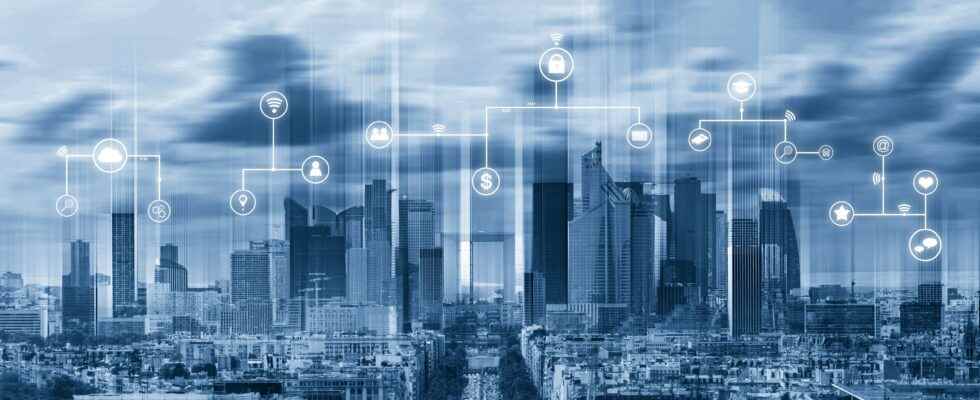A broken traffic light posing a danger to pedestrians? With an application, a citizen can notify the town hall so that it acts as quickly as possible. It can also, via a citizen consultation platform, decide on the projects envisaged by the municipality and the distribution of a budget, or even submit its proposals spontaneously.
For its part, the municipality itself can, by means of sensors, check whether the bins are overflowing in a district; ensure that there are no water leaks on the network; identify lights left on in offices at the end of the day; manage the intensity of the lighting of a street lamp when a night walker passes by; but also know, in real time, the available parking spaces, the state of traffic in the streets, as well as the quality of the air or the water at the tap.
The interest? To be able to act accordingly and adopt appropriate policies, in accordance with the wishes of the populations. On one condition, however: to be able to analyze all the data collected. In short, on condition of being “a smart city” or rather, as Mathieu Vidal, lecturer in geography and planning at the National University Institute Champollion in Albi, says, a “connected city”.
“Large-scale projects in Dijon or Angers”
The expression “smart city”, modeled on the English smart city, is somewhat shunned today by experts. Indeed, when it emerged in the early 2000s, the concept gave pride of place only to large private companies, such as Cisco and IBM, then solicited by Bill Clinton with the aim of making cities more sustainable and which benefited from it. to sell their services…
Still, in France, “there is a real movement, with large-scale projects, in cities like Dijon or Angers, but also in small villages, notes the sociologist Jean-François Lucas, director of the “intelligent and digital territory expertise responsible for the research and consulting office Auxilia-Chronos. Moreover, it is not about tech for tech’s sake, and we now speak more readily of ‘human cities’. ” Mathieu Vidal completes: “The idea is to integrate IT uses to benefit from better resource management and work towards a better quality of life for residents.”
According to estimates cited by the Digital Society Lab of the National Agency for Territorial Cohesion, in 2021, more than 200 metropolises had launched projects in this direction, including Paris, Lyon, Angers, Toulouse, Annecy, Dijon, Dunkirk, Grenoble, Issy-les-Moulineaux, Montpellier, Nice… Thus, Angers Loire Métropole, which wants to become the first smart territory in France, has retained Engie associated with Suez, La Poste and Groupe VYV in 2019 to develop solutions in the aim of optimizing the organization of public services, ensuring better management of resources and making life easier for residents.
Significant savings on public lighting
For example, the metropolis intends in particular to reduce the bill for public lighting by two thirds by 2025 thanks to this ecosystem which brings together public administration and private companies. For its part, Dijon Métropole, with the support of Suez, Bouygues Energies & Services, Citelum (a Dalkia Electrotechnics brand for local authorities) and Capgemini, commissioned a connected cockpit for public space equipment in 2019. of the 23 municipalities that make it up. Since then, it has organized an annual “Data Challenge” on this theme with various start-ups. This year, the start-ups were thus called upon to propose solutions in response to three questions: “How to predict the state of the tree heritage and anticipate the risks?” ; “How can revegetation make the territory more pleasant for citizens?” ; “How can the smart city promote the inclusion of citizens?”
Without a doubt, the Covid, energy and climate crises have accelerated the use of these various digital tools. The reason ? “They encourage action to save water, electricity, preserve nature, ensure air quality, etc., says Emanuel Eveno, researcher at the CNRS Interdisciplinary Solidarity, Societies, Territories Laboratory. But it does not work well only if the citizens play the game.” And to illustrate his point with the example of sensors installed on parking spaces to check their use: “Some users did not always park in exactly the right place. As a result, the sensors could not bring up the data. .”
Do not aggravate the digital divide
Suffice to say that, for a city, a digital strategy is built down to the details… “And excess is never good, warns Isam Shahrour, professor of civil engineering and smart city at Polytech Lille. A city can boast of having installed thousands of sensors, but if they are useless, it does not improve the quality of service or the lives of the inhabitants.” And there is no question either, with a very connected city, of running the risk of increasing the digital divide. “If we want citizens to become observers of the common goods on the territory, we must take care not to leave behind certain inhabitants who are not connected”, he adds.
Finally, while some have for some time advanced the idea that the use of tech in the city would have the virtue of energizing citizen engagement, this specialist is content to speak of greater involvement on the part of the inhabitants. “Which is already an advantage compared to passivity, even defiance,” he says. Digital is, in fact, “just one more tool to seek out a certain type of audience, employees who cannot go to public meetings, for example, or young people experienced in its use”, confirms Jean-Francois Lucas. And Emmanuel Eveno to decide: “I’m not sure that the digital city aims to improve citizen engagement, he says. On the other hand, what is clear is that it can only work with this commitment.” Provided that data security and confidentiality are ensured.
